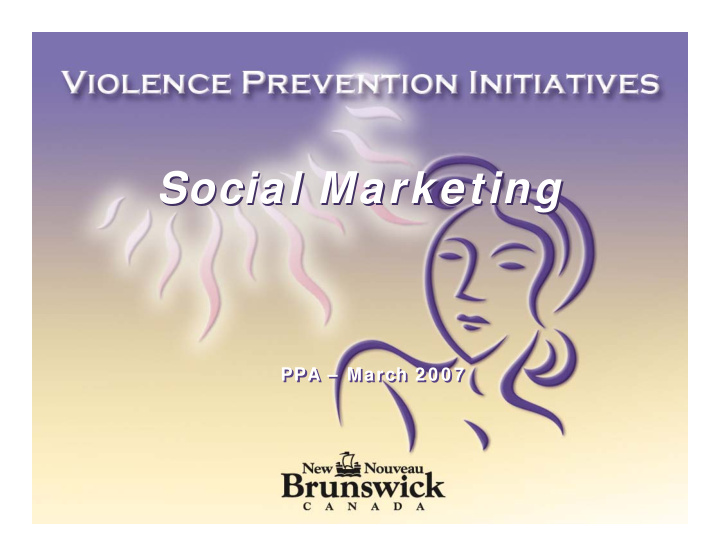



Social Marketing Social Marketing PPA – March 2 0 0 7 PPA – March 2 0 0 7
Objectives • Overview of Social Marketing principles • YOU as a social m arketer
W hat is Social Marketing? • Social Marketing “is the use of com m ercial m arketing techniques to prom ote the adoption of a behavior that w ill im prove the health or w ell-being of the target audience or of society as a w hole.” ( N.K. W einreich, “Hands-on Social Marketing” ( Sage, 1 9 9 9 ) .)
Key Messages • Action is the objective • Target audience is critical
W hen w ould I use a social m arketing approach? • Develop a public aw areness cam paign • Create prom otional or educational m aterials • I m prove services • Create new program s ( W einreich, 1 9 9 9 )
Social Marketing vs. Com m ercial Marketing • Builds on 4 Ps of com m ercial m arketing • Distinction: Benefits accrue to the individual or society
Social Marketing Framework 1. Planning 5. Evaluation 2. Development 4. Implementation 3. Pre-testing
STEP 1 : Planning Stage PROBLEM ANALYSI S ENVI RONMENT ANALYSI S Background inform ation on Law s & policies • • the issue Other cam paigns • The behavior change you w ish • Social norm s • to prom ote Available com m unication • The purpose of the cam paign • channels ( intended im pact if RESOURCE ANALYSI S successful) Budget I dentify target audience • • Partners I dentify barriers to a behavior • • Staff capabilities •
I dentify your Target Audience • Group( s) of people w hose behavior you w ant to change • Market segm entation
Som e w ays to segm ent the population: • Geographically: by location • Dem ographically: by socio-econom ics – age, incom e, gender • Psychographically: by such things as attitudes, values, lifestyles, and opinions ( Health Canada 2 0 0 5 )
More w ays to segm ent the population • Theories of behavior change
STAGES OF CHANGE MODEL Pre-contem plation • Contem plation • Preparation • Action • Maintenance • ( Prochaska & DiClem ente, 1 9 8 3 )
Stage of Possible Change Strategy Aw areness Pre-contem plation • • Em phasize benefits Contem plation • • Minim ize barriers Preparation • • Positive reinforcem ent Action • • Positive reinforcem ent Maintenance • • and coping tips ( W einreich 1 9 9 9 )
Researching the target audience • Focus groups • Surveys/ interview s • Observational studies • Academ ic research • Census data • Marketing databases
Analyzing the target audience Level of aw areness of the issue • Myths and m isconceptions • W here do they get their inform ation about the issue • Current attitudes • Current behaviours • Perceived benefits of the proposed behaviour • Perceived barriers of the proposed behaviour • Media and leisure habits • W hat organizations do they belong to •
Key findings influence … • The identification of one or m ore target audiences • Program developm ent, im plem entation and key m essages
STEP 2 : Developm ent Stage • Product • Price • Place • Prom otion
PRODUCT Refers to… • The behavior/ product being prom oted • The objects/ services offered to support the behavior change • The key benefits that w ill be derived from perform ing the behavior • W hat is the com petition for your product and how is your product different
PRI CE Refers to… • The costs ( m onetary or non-m onetary, such as tim e, em otional cost, physical discom fort, em barrassm ent, disapproval, etc.) individuals associate w ith giving up the old behavior and adopting the new behavior
PLACE Refers to … • W hen and w here the target audience accesses the program products/ services or w here they get their inform ation
PROMOTI ON Refers to … Getting the m essage out through Radio • Television • Special events • Prom otions • Entertainm ent •
STEP 3 : Pretesting • I m portant to pre-test your m essage and/ or product to avoid unintended affects and to illum inate barriers • Assess and refine until it is effective
STEP 4 : I m plem entation • Develop an im plem entation plan
STEP 5 : Evaluate • Process • I m plem entation objectives • I m pact Com m unity Tool Box - http:/ / ctb.ku.edu/ tools/ tk/ en/ tools_ tk_ 1 3 .jsp
Social Marketing Exam ple Health Canada “Back to Sleep” – w w w .toolsofchange.com / English/ CaseStudies/ default.asp?I D= 1 6 1
YOUR TURN!
Recommend
More recommend